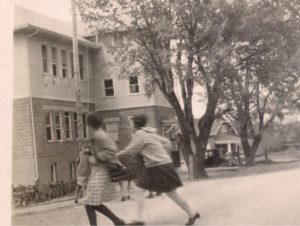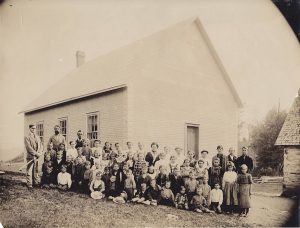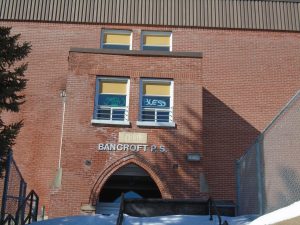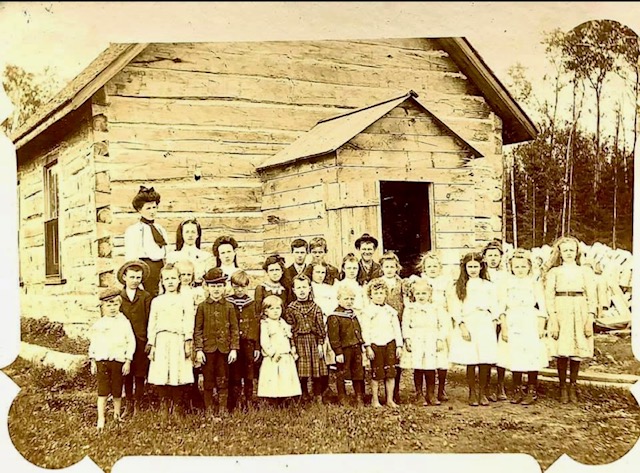EDUCATION IN NORTH HASTINGS
The first Bancroft Public School was built circa 1870 just south of Quarry, a.k.a. Marble Lake, on the old Hastings Settlement Road. William Davy, Senior, originally settled his family on land between L’Amable and Quarry Lake. According to the author who signed his name I.W.T. (guess what those initials mean) “the older children attended school south of Quarry Lake which Mr. Alfred Barker said was the first school north of Madoc. The tumble-down log building that had housed the school was still standing by the roadside in the early years of this century (1900s) and I had it pointed out to me as the place where my father obtained his education.” (IWT)
The second school, called York River School, was a single roomed log structure built in 1877 on John Street, “near where the Robinson home was situated.” The Chinese restaurant, formerly called “Mom’s,” across from Vance Motors, is near its location. The teacher was Miss Sarah Cooper followed by Miss Murray. (Perhaps the Robinson home was the location of Robinson’s furniture which was located across the road from the former Shell gas station where an RCAF helicopter crashed and where Vance motors does its detailing. Last I knew a hair salon was in that location.)
Marguerite McColl, nee Davy, tells of her father attending this school. “Dad told of a bear cub that kept wandering into the school yard. He also talked about his teacher, a Mr. Johnson, who was apparently good looking because a lot of girls suddenly started attending school. One day, while taking attendance, he got to the last girl and he said: “You’re 23, meaning number 23 of course. Well she got rather indignant and informed him that she was not 23 but 21!” (Marguerite lived past 100. She first taught at the Wooler school, was principal at Coe Hill School and taught with my wife at Hermon Public school in the early 70s.)

The Red School House was number three built circa 1898. It also was a one-room log structure and was built to the east of the present school, the site of a playground to-day. Later a second room was added. The first teacher was Miss Elizabeth Kavanagh who became Mrs. Rouse. It is she who planted the first maple trees on the school grounds in her first year. It was probably an Arbour Day project. Do you remember Arbour Day?
The classrooms were dramatically different from to-day, benches instead of desks and writing slates for notebooks. Books weren’t that numerous and much was assigned to memory. School grades were different. There were: grade 1, Senior 1; grade 2, Senior 2; grade 3, Senior 3; grade 4, Senior 4 (to-day’s grade 8) followed by Continuation School (grades 9-12). For Upper School (grade 13) the students had to go further afield to Madoc, Belleville, Frankford, Tweed, Trenton … often to stay with relatives. The author I.W.T. attended the “little Red Schoolhouse” (BPS) in 1904 according to archival records from THE BANCROFT TIMES.
It appears that students had to write entrance examinations in order to attend Continuation School. In July 1911 published results in THE TIMES indicated that 17 of 49 candidates were successful. These included: John Drury, Irene Liddle, Lilly Levine, Agnes Henderson, Ella Lindsay, Olga Davy (Mrs. McColl’s older sister), Florence Wilson, Herbert Maxwell, Mae McGinnis, Emerson Laundry and Bert Power. “Some of these were from out of town schools”. (Note: Friend Peter Brown’s uncle Herbert Maxwell never returned from WW1.)
The fourth BPS was built in 1913 and opened in 1914, the date synonymous with WW1. It contained 6 elementary rooms and 2 Continuation rooms. It burned during the winter of 1931.
“The school was right next door to the Aunt’s house, just beyond their garden area. It was not the tidy ‘little red schoolhouse’ that Margy remembered from her previous visit four years earlier; that had burned down in 1931 the aunts told her, and this large new brick building had replaced it.” (From MARGY by Margaret Smith.)
Mrs. McColl, who had graduated around 1927 from the school that burned had gained her Upper School grades in Campbellford and then graduated from Toronto Teacher’s College. “I was teaching in Wooler when I was told that BPS had burned.” Both teachers and their students were farmed out all over town. From “North of 7” Sue Hillis set the scene: “The grade 1 was over the drug store and the bank (now Floral Traditions). It was one big unfinished room. We had no desks, just planks on sawhorses and benches…There was no playground, so there was no recess. Two or three times a day our teacher, Albert Warren, would get us up to do exercises…when he had us jumping and clapping our hands over our heads the old building would shake. The clerk in the drugstore downstairs would have to keep things from falling off the shelves.” According to “North of 7” the new BPS was built in 1932. No dates seem to exist to verify the discrepancy of dates although the corner stone does apparently state 1931.

Notes to Teacher: “Dear Teacher – I dink you are a fool, you want my boy to read when he don’t have no aiferbits. Please teach him some.”
“Please excuse Fritz for staying home. He had der measles to oblige his father.”
“You must stop teaching my Lizzie Fisical torture, she needs yet readin’ and figures mit sums more as that, if I want her to do jumping I kin make her jump.”
And, when asked why the school records show that he missed a lot of school one winter Henry Taylor just laughs and says that “the snow was too deep and my legs were too short.”
An editorial proclaimed that “there was a vacancy in one of our district public schools recently and applications were received from 15 gentlemen and 39 ladies. If this sort of thing keeps on,” it laments, “there will soon be nobody to do housework and saw wood.”
I.W.T. (I Was There) was the pseudonym of Warren Davy, a cousin to Mrs. McColl. He was born circa 1895, enlisted for WW1 and with government assistance became a teacher after the Great War and taught in British Columbia. He wrote a series of columns about his past recollections. As mentioned previously he attended BPS, the little red schoolhouse, in 1904.
The following he titles – “Singing! If you could call it that.”
I always loved to sing. I knew most of the words of the popular songs and I thought I knew the tunes but I was the only person who seemed to enjoy my efforts. Sometimes when I was singing with a group I would notice someone looking at me with a rather peculiar expression but I never attached much significance to it. Some of my acquaintances did hint at a lack of ability to follow a tune and one or two were more outspoken but this did little to dampen my enthusiasm.
Our teacher, Edison McConnell, was a lover of song but whether or not he was a capable teacher of music I am in no position to judge. Often on Friday afternoons after recess he would take the senior pupils into the junior room where the pupils doubled up in the seats so the girls could sit down and the older boys stood around the walls. There we sang all the patriotic songs that were so popular in those days, “The Maple Leaf Forever”, “God Bless His Majesty”, etc. I certainly enjoyed those periods.
One winter the school put on a concert in the Town Hall. It was a major effort and proved to be quite an elaborate affair and was very successful. A few days before the actual performance we were practising the songs we were to sing at the concert. E.D. was exasperated. Someone was constantly off key or out of tune, whichever is the correct term. An inner voice suggested that I refrain from singing. On the next attempt my lips moved but they produced no sound. The teacher was delighted and from then on everything went splendidly. I continued to go through all the motions but the others did the singing. The applause was tremendous.
Throughout the years I continued to enjoy my own singing. My hearers were never enthusiastic but were usually too well mannered to make uncomplimentary remarks. Then one afternoon I got a real setback.
Our next door neighbour was a keen hunter. He kept two hounds in his back yard. They really lived for two weeks each autumn when they were taken by car to Parry Sound or Haliburton. The remainder of the year they were chained in front of their kennels; were quiet and friendly and gave little annoyance to the neighbours.
I had been working on the lawns and in the garden all morning and in the early afternoon I went upstairs to get cleaned up for the rest of the day. It was a lovely day; the windows were wide open and I was really enjoying myself giving my best rendition of some of my old favourites when suddenly the hounds joined the chorus. They really entered into the spirit of the thing and the whole neighbourhood was entertained by their yodeling. My wife came to the foot of the stairs and called up, “Now see what you’ve done.”
That really dampened my enthusiasm.
THE BIG ROCK by I.W.T.
Note: NHHS was built on Bancroft’s old Fair Grounds. The Bancroft Board of Education purchased the land for $1.00.
The big rock has gone; even the ground where it reposed for thousands of years has been covered over by the works of man. Old landmarks have to disappear before the strides of human progress. There is little doubt that where the rock rested undisturbed through the centuries was the most suitable spot for the High School cafeteria. And the workmen who removed the huge boulder were not perturbed by the memories of childhood years spent in that locality but for me the announcement of its disappearance brought a feeling of nostalgia as I recalled the happy hours spent on or near The Big Rock. It stood on the brow of the hill overlooking the old Fair Grounds. Whether it had been brought to that spot in the Ice Age and left behind when the ice retreated or if it was just the top of a Laurentian hill from which the erosion of centuries had carried off the soil and smaller rocks leaving it thrust up several feet above the surrounding terrain I know not nor does it matter.
The last time I sat on the rock a few years ago and looked around at the altered landscape the rock itself seemed smaller than it had over half a century earlier but that was to be expected. How often I had sat on that very spot with my brothers and sisters or with some of our cousins and had eaten our supper there. One of our greatest childhood pleasures was to take our supper out and The Big Rock was the spot most frequently chosen for the occasion.
As I rested there I traced with my finger my initials that with a coal chisel and hammer I had carved over fifty-five years ago. Time, wind and rain had worn them away until they were scarcely noticeable. A few feet away were the faint imprints of those put here by my brother, the one who so long ago in Flanders Fields had given up his life for his country because of the mistaken idea that his sacrifice might help to make the world a safer place for others.
On another part of the rock, very dimly indeed, could be seen my cousin’s initial. I recalled the morning when we three had taken hammer and coal chisel and had gone to the rock to leave our imprints for posterity. We didn’t say that nor did we think it. We were just carving our initials as so many thousands do every year in all kinds of unlikely and often less suitable places.
On the sidehill, just below, we had gone sleigh riding on the frozen crust. I had fallen off the sleigh and got a nasty cut on my head. On the flat a couple hundred yards away my brother and I played two-man baseball against Jim and Jack McAlpine.
But now The Big Rock has disappeared and with it the memories of long ago. Perhaps it is better to forget the past and turn our thoughts to the present time but in the present here are so many things that we don’t like to think about too much so it is a pleasant relief to let our memories drift back to those earlier days when life didn’t seem to be quite so complicated as it is today. (Remember, this was penned in the early 1960s. –Ed.)

Note: In 1969 the Bancroft Board of Education joined Hastings County and formed the Hastings County School Board which is now, of course, the Hastings Prince Edward District School Board. In the late 1980s, early ‘90s I used to convene the County Cross Country meet at the Senior Elementary School. When I phoned the schools in The County after The County joined our board I discovered that the schools were all on party lines. How times change. And Bancroft Public School has been replaced with new apartment buildings. The students have been moved to the former Senior Elementary school which formerly was a grade 7/8 intermediate school. Renamed York River Public School it is home to grades JK – 6; the 7 and 8s having moved on to NHHS which was built in 1949. The cedars that spell NHHS at the front of the school, downhill from the cafeteria, were planted by teacher Andy Ellenberger’s agricultural class in the early 1970’s. FYI. – Ed
